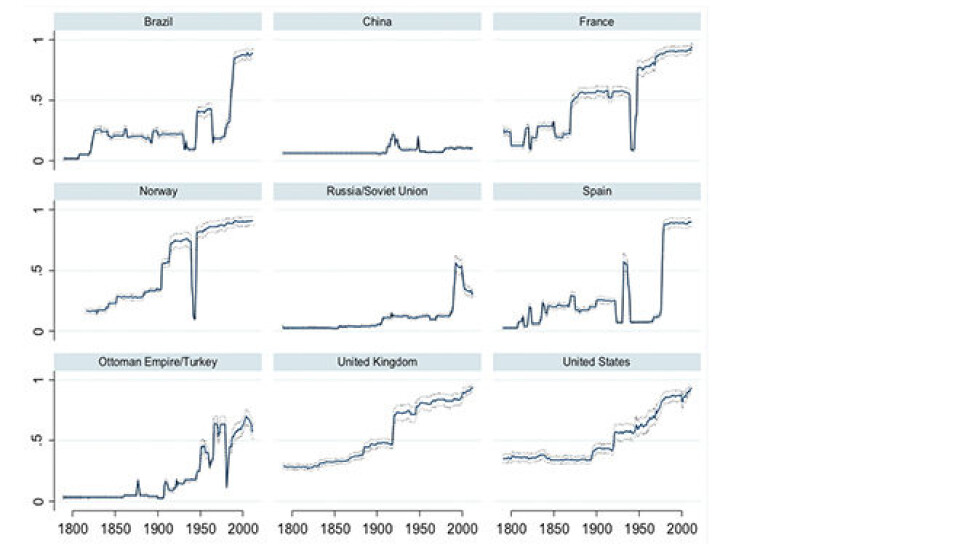An article from University of Oslo

What democracy looked like 200 years ago
How democratic was Norway in 1814? A new dataset allows you to explore the different dimensions of democracy from 1789 until now.
Is a country democratic if it has free multi-party elections? Few would disagree to the statement that Norway is more democratic than Mozambique. Yet both countries have open elections. However, political scientists often define democracy more broadly than just looking at multi-party elections. How democratic a country is, according to some definitions, also depends on factors such as freedom of speech, executive corruption, bans on political parties, characteristics of civil society, etc.
"Democracy is a complex concept to define, and even more complicated to measure. But, using different measures from our new dataset, we do certainly see different degrees of democracy," says Carl Henrik Knutsen. He is one of the principal investigators of Varieties of Democracy (V-Dem).
"Using this dataset you can also see where well-known democracies such as France and the UK score relatively low, but also where otherwise autocratic states score relatively high."
Opens up for new studies
The recent V-Dem dataset is the most wide-ranging dataset on democracy and political institutions available – including several hundred indicators and indices for countries across the world. With the newly released version, the dataset integrates Historical V-Dem data, which spans all major countries and several other polities globally, covering 1789-1920. This opens up for new studies on key questions on the causes and consequences of institutional development across modern history.
Several researchers and research assistants at the University of Oslo have been heavily involved in this data collection effort, with project funding from the Norwegian Research Council.
From the legal status of slavery to statistical agencies
Historical V-Dem covers different areas of political life, including surveys on the following topics: Elections, parties, executive, legislature, judiciary, civil liberties, state, civil society, media and political equality. The data include 110 indicators coded by research assistants at various universities across the world as well as 149 more evaluative indicators coded by country experts. The former involve features such as election dates, names of local government entities, the legal status of slavery, and the existence of statistical agencies, to name a few examples.
The latter indicators pertain to features such as the extent of election violence, the relative power of elected and non-elected offices locally, de facto freedom from forced labor, and the extent to which recruitment to the bureaucracy is merit-based. But, these are only some examples of the indicators contained in the dataset.
"The reason why we chose to include the indicators that we do is that they make up important elements of political systems – across the world and across modern history – that political scientists and others have long been interested in studying," says Knutsen.
A range of methodological measures have been taken to ensure that scores on these and other indicators are not only valid and comparable across countries, but also comparable across the entire time frame from 1789 to the present.
The era of state building
While the majority of indicators are extensions from V-Dem, about 70 are new indicators to Historical V-Dem, many with special relevance for the 19th century. The 19th century was an era of state building, and Historical V-Dem contains several new indicators on state bureaucracies, armed forces, and various other agencies. For example, Historical V-Dem includes indicators on how bureaucrats (and army officers) are recruited and remunerated. These variables will, for example, allow for systematic, empirical studies of processes of modern state formation, a topic that has so far largely been studied using lengthy case narratives.
Other new indicators pertain to “regimes”, including when and how a particular regime ended, the size of its support coalition, its geographical location, and which social groups are included in that coalition. These data will allow, for example, testing arguments on how particular social groups, such as agrarian elites, industrial workers, or the urban middle class, affect democratization chances.
"These are questions that colleagues at the University of Oslo and I – and many others – have long been interested in studying, and that we want to address going forward," says Knutsen.
While V-Dem is headquartered at the V-Dem Institute, University of Gothenburg, the Historical V-Dem data collection has been led from Lund University and the University of Oslo. Yet, the data collection has involved numerous researchers, located at different institutions across the world. The dataset is free and open to all. You can download the data or do online analyses at the V-dem webpage.






























